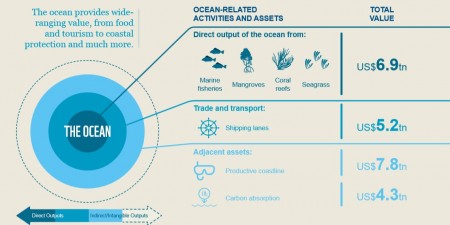
It is good to know that we humans have done our audit and determined what the oceans are worth. The chief architect putting a price tag to 70% of the planet is Ove Hoegh-Guldberg, an Australian marine scientist and director of the University of Queensland’s Global Change Institute.
Totaling up the ocean’s assets which include fisheries, shipping lanes and tourism Hoegh-Guldberg has come up with the number $24 trillion US. And in addition the annual value from ocean output is calculated to be worth $2.5 trillion. Note that the calculation doesn’t include all those deep water and offshore oil rigs, the methane hydrates on the ocean floor, the tungsten nodules that mining companies seek, or the wind, tidal and wave renewable energy projects sprouting up along coastlines.
So $24 trillion really is a significant underestimate of the asset’s real net worth. For those putting a dollar value on the ocean the number is considered a pretty good starting point. It makes the ocean the seventh largest economy in the world after the U.S., China, Japan, Germany, France and the United Kingdom. The dolphins, marine mammals and whales, phytoplankton, krill, coral reefs, fish, squid, octopi and other creatures must be thrilled to know their home and they have been appropriately priced.
Put a price on the ocean – why?
In treating it like it is a corporate balance sheet Hoegh-Guldberg and the World Wildlife Fund (WWF) are hoping to launch a new strategy – pricing will lead to protection and conservation because the immense asset value will finally be understood by the general public. The WWF, therefore, is making ocean as asset the way forward to ensure sustainability and survivability.
On its website WWF declares:
“The ocean…puts food on the table and underpins trillions of dollars of economic activity worldwide. It does all online casino’s this freely….Because the ocean belongs to everyone – and to no one…..It is time to change the way we see the ocean – from a place where we take what we want and dump what we don’t, to a shared resource of immense value.”
In the new report, entitled Reviving the Ocean Economy, Hoegh-Guldberg annd The Boston Consulting Group, make the economic case for ocean conservation establishing three priority actions for 2015 ( highlighted in bold) plus five follow up actions for the years to follow. These include:
- Get the United Nations to establish sustainable development goals in the marine environment for the next 15 years addressing issues such as habitat destruction, overfishing, illegal fishing and marine pollution.
- Get global commitment from nations to address ocean warming and acidification at the December 2015 climate change conference in Paris focusing on a strategy of rapid decarbonization for all human society.
- Commit coastal nations to create conservancy areas covering at least 10% of their coastal and marine areas by 2020 and 30% by 2030.
- Address the over-exploitation of world fisheries standing today at 28.8% with 61.3% now fully exploited, focusing on sustainable habitats and better fisheries management.
- Create a “Blue Alliance” of coastal nations to share responsibility in decision making about the ocean.
- Establish public-private partnerships focused on solutions for ocean sustainability.
- Get all maritime nations to publicly account for the assets of their marine environment and ocean activities.
- Create a common knowledge-sharing ocean platform of critical information and expertise about all aspects of the ocean.
The WWF’s final message to marine nations is this: we cannot afford to push the ocean economy into the red. Acting now will mean a sustainable future for the hundreds of millions of humans who depend on the ocean for food and jobs. Interestingly there is no mention of the rest of the biology that depends on the ocean for life. They don’t get to vote.
Originally published by 21stcentech.com.



